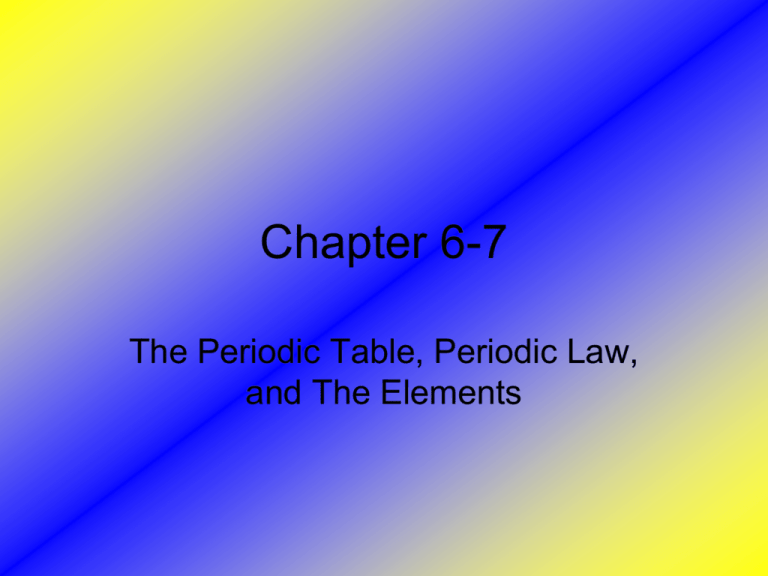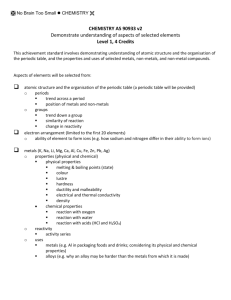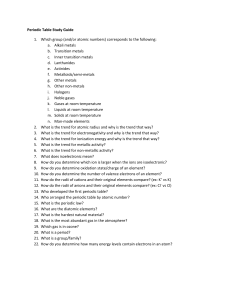Power Point
advertisement

Chapter 6-7 The Periodic Table, Periodic Law, and The Elements Periodic Table • Elements are arranged in increasing atomic number according to similar properties in columns or groups • It was developed over decades • 1790’s- Lavoisier compiled a list with 23 elements John Newland • 1864- arranged elements by the “law of octaves” • (1st arranged) – right idea but not exactly right after the first 14 or so. Demitri Mendeleev (1834-1907) • Russian • 1869- designed the “modern table” Moseley slightly rearranged based on atomic number and created our basic modern table Periodic Law • There is a periodic repetition of properties when arranged by atomic number Groups • Also called families (vertical columns) • Share similar properties – End in same econfiguration – Same valence e– Same reactivity Period • Horizontal rows • Share same highest energy level Periodic trends • Atomic radius- half the distance between the nuclei of identical atoms that are bound together – Group trend: increase down Atomic radius increases down because as you go down there are more electrons and more energy levels and with each energy level you get further from the nucleus. – Periodic trend: decrease left to right Atomic radius decreases from left to right because when you go across a period electrons are being added to the same energy level, which makes a stronger attraction and pulls electrons closer to the nucleus resulting in a smaller atom. Ionic radius • Ion- has a charge (+ or -) – when an atom gains or loses an e• Cation- positive ion- lost e- - smaller than neutral • Anion- negative ion- gained e- - larger than neutral *** same trend as atomic radius Ionization energy • • • • • • Energy required to remove an eEach e- has its own energy 1st IE<2nd<3rd Group trend: decreases down Period trend: increases across These trends are both due to the fact that electrons are more difficult to remove from stable elements Electron affinity • Energy change that occurs when an e- is acquired by a neutral atom • Fe + e- Fe- Electronegativity • Relative ability of an atom to attract electrons to itself in a bond – Pauling electronegativity scale – Period: increase left to right – Group: decreases down – General trend: increase up and right F=most electronegative O=second most Fr=least Hydrogen and helium • Unique- can both occupy 2 groups • H= 1A & 7A • He= 2A & 8A • 99% of Universe • 76% = H • 23% = He Alkali Metals: groups 1 or 1A • Alkali comes from Arabic“ashes” • All are very reactive, react violently with H2O, soft, low density, low melting pts. • Li- batteries, dehumidifiers, bipolar disorder medication • Li2CO3 -in glass, airplane parts • Na- salt, vapor lamps, heat exchanger in nuclear reactors, electrolyte • K- electrolyte for muscles, one of 3 main ingredients in fertilizer – KNO3 in large scale fireworks and gun powder Alkaline Earth metals: group 2 or 2A • All but Be form oxides that will not melt and form basic solutions • Less reactive than 1A • More dense, higher melting points • Be- with Al, Si, and O makes beryl (emerald/ aquamarine), moderates neutrons in reactors, Be/Cu alloys are used for tools where no sparks can be formed like refineries • Mg- backpack frames, bicycle wheels, “mag” wheels, oxide used to line furnaces, every chlorophyll has 1 Mg+2, muscle function and metabolism- found in “hard” H20 with Ca +2 Alkaline earth metals continued… • Sr- crimson fireworks • Ba- paints, additive in glass, diagnostic tool in medicine • Ra- highly radioactive, once used in glow in the dark paint for watches Aluminum Group: group 13 or IIIA • B- metalloid, Borax is the name of the mined compound • B/Si/O=borosilicate=pyrex • Mined in the Mojave Desert Boric acid: disinfectant, ant repellant Boron nitride: second hardest substance Aluminum group continued…. • Al- cans, foil • most abundant metal on earth • 3rd most abundant element on earth • Mined from bauxite – Strengthens ceramics, heatresistant fabric, ruby and sapphires are mainly Al2O3 – Al2(SO4)3- alumantiperspirant and water purification Al group Continued….. • Ga- used in some thermometers from 30o to 2400oC – Gallium arsenide produce photoelectric cells – Solar power=calculators – 10x more efficient than Si chips – Gallium nitride- used for blue lasers (can triple storage) Carbon group: group 14 or IVA • C- has its own studyorganics – Exist in at least 4 natural forms – diamond, graphite, coal (soot), Buckminster fullerene Carbon group Continued….. • Si- computer chips, solar cells, 2nd most abundant element in the crust, most common form is silica, (Si02) A.K.A sand, glass, quartz – Silicon carbideindustrial abrasive (carborundum) Carbon group Continued…. • Ge- metalloid- solid state electronics • Pb- toxic, was in paint, may have been 1st pure metal, additive in glass, causes brain damage • Sn- coating for cans, Bronze, construction materials, foil Nitrogen Group: Group 15 or VA • N- colorless, odorless, unreactive-= 80% of air; compounds- fertilizer, explosives (TNT), DNA, Ammonia (cleaning), dyes, nitroglycerin – HNO3- used to etch metal plates and other industrial uses Nitrogen group continued.. • P- has 3 allotropes (white, red, black), phosphoric acid, processed cheese, laxatives, matchbox, baking powder, fertilizer, ATP, DNA, detergents Nitrogen continued… • As- toxic, Arsenic sulfide was used as medicine, metalloid • Sb- antimony sulfide was used as a cosmetic to darken eyebrows and make eyes appear larger, 5% of modern Pb storage batteries, Sn/Sb alloy can be molded (tableware)- metalloid Nitrogen Continued…. • Bi- Pepto Bismol, Bi/Pb/Sn/Cd alloy called woods metal used as a plug in sprinkler system Oxygen Group: group 16 or IVA • O- 2 allotropes 02/03--most abundant element on earth -bleaching agent 50% of earth crust= 20% of air Oxygen Continued… • S- 10 allotropes -Cinnabar, galena -can be found in nature in pure form (yellow) H2S04= fertilizer production, steel, paper, paint silver tarnish is H2S + AgAg2S Oxygen continued… • Se- works with Vitamin E to prevent cell damage, can be toxic= RDA= 10 mg, toxic L050= 200 m/m3, can convert light to electricity- used in solar panels, photographer meters, photocopiers, semiconductors • Te- metalloid- semiconductorsrare • Po- named for Poland- rare, radioactive, toxic Halogens: Group 17 or VIIA • Most reactive nonmetals- “halo”salt “genero”- form= salt formers • State of matter at room temp. • F, Cl= gas • Br= liquid • I, (At)= solid Halogens continued…. • F- most electronegative element- most active element – “fluere”- latin, “to flow”added to H20 and toothpaste to prevent decay, teflon= F/C compound reacts with U to form gases (U enrichment) U-235 Halogens Continued… • Cl- deadly gas in its pure form -can be a disinfectant -NaCl=bleach -nerve blocker in medicine HCl- removes rust or algae, etc. (muriatic) -mixed with oil=PVC (Poly Vinyl Chloride) Halogens Continued… • Br- photographic film • I- photographic film, needed to maintain a healthy thyroid (controls growth and metabolic rate), disinfectant, iodized salt • At- radioactive, man-made Nobel Gases: group 18 or VIIIA • All were considered inert (nonreactive) until the 1960’s • He, Ne, Rn- still no compounds Noble gases continued… • He- used in balloons, blimps, and dive tanks -liquid form=coolant -superconducting magnets -pale yellow “neon” lights • Ne- first “neon” light -bright orange Noble gases continued… • Ar- insulation in windows, 1% of air, blue “neon” light, atmosphere of incandescent lights, high temp. welding • Kr- used as insulation in windows • Xe- 1st to form a compound • Rn- deadly radioactive gas from U decay, found under homes Transition metals • D-block- groups 3-12 – B elements • Various uses and forms -Cobalt 60=chemotherapy -Fe= construction -Fe, Co, Ni= magnets -Ag, Au, Pt= “precious” metals -Cu= wire -Co= red blood cells -Mn= cell respiration Inner transition metals • The “f” block • Lanthanide and actinide series • Ce= used to remove C from steel, movie projectors, search lights • Pu= 239 reactor fuel • Am= smoke detectors • Nb, Pr= welding goggles • Yb, Eu= TV screens, computer monitors







